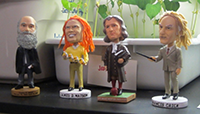Service to the Community
Our service to the community reflects our ongoing commitment to working with students and teachers in K-12 settings. In addition to the many projects each of us does on his or her own, the group has collaborated on the following efforts:
No Bones About It (2013). This project, which grew out of a Partnership mini-grant, provides an opportunity for the science education faculty to collaborate with each other, as well as with pre-service elementary teachers, and fourth grade teachers from CC Wright to plan and implement science lessons that integrate language arts. Using a set of animal skulls as the centerpiece of the inquiry-based science portion of our lesson, we are expanding on hands-on lessons by incorporating non-fiction science books.
A Hoot and a Holler: An Interdisciplinary Owl Unit. A Collaborative Effort Among University Professors, a 4th Grade Classroom Teacher and Her Students (2012). This project was also funded by a Partnership mini-grant. Two members of the elementary science education group and a language arts educator worked with a fourth grade teacher to design and implement an integrated unit related to owls.
Upward Bound Presentations and Workshops (Ongoing). Over the last two years, our group has been working with the Upward Bound program to bring science demonstrations and workshops to students participating in this residential summer program. This partnership is continuing this summer, with Rachel Wilson helping lead a group of high school students on a trip to Puerto Rico.
Human Wonder Research Science Presentations (Ongoing). For many years running, over1500 students per year attend science demonstration shows given by members of our Elementary Science Education team. These presentations, supported by the North Carolina Appalachian Collaborative for Higher Education and the Math Science Education Center, are designed to get students excited about science as well as interested in coming to college. The collaborative spirit with which we test and develop new demonstrations for these shows is an example of the way our Community of Practice helps us reach out to the wider community as we also grow professionally ourselves.
